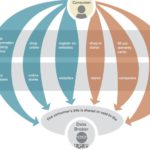In “I feel therefore I am“, an essay published in aeon, Margaret Wertheim sketches the history of consciousness as a problem.
“In An Essay Concerning Human Understanding (1690), John Locke wondered if ‘the same object should produce in several men’s minds different ideas at the same time; for example, the idea, that a violet produces in one man’s mind by his eyes, were the same that a marigold produced in another man’s, and vice versa.’ Now known to philosophers of mind as the inverted spectrum argument, Locke’s query points us to the mystery of subjective experience and its attendant problem of ‘consciousness’.(…)
First coined in 1995 by the Australian philosopher David Chalmers, this ‘hard problem’ of consciousness highlights the distinction between registering and actually feeling a phenomenon. (…)
As one of the founders of empiricism, Locke believed that knowledge comes primarily from sensory experience, with real knowledge beingfelt by conscious beings. In the 17th century, René Descartes had also insisted on the irreducible centrality of subjective experience (…)
(…)
The idea that the laws of nature might be able to account for conscious experience – a position known as physicalism – steadily gained supporters in the 19th century and was given a particular boost with the advent of Maxwell’s equations and other powerful mathematical frameworks devised by physicists in their golden age. (…)
Yet, as some philosophers of the early 20th century began to point out, physicalism contains a logical flaw. If consciousness is a secondary byproduct of physical laws, and if those laws are causally closed – meaning that everything in the world is explained by them (as physicalists claim) – then consciousness becomes truly irrelevant. (…)
These are fighting words. And some scientists are fighting back. In the frontline are the neuroscientists who, with increasing frequency, are proposing theories for how subjective experience might emerge from a matrix of neurons and brain chemistry. A slew of books over the past two decades have proffered solutions to the ‘problem’ of consciousness. Among the best known are Christof Koch’s The Quest for Consciousness: A Neurobiological Approach (2004); Giulio Tononi and Gerald Edelman’s A Universe of Consciousness: How Matter Becomes Imagination (2000); Antonio Damasio’s The Feeling of What Happens: Body and Emotion in the Making of Consciousness (1999); and the philosopher Daniel Dennett’s bluntly titled Consciousness Explained (1991).
It has been said that, if the 20th century was the age of physics, the 21st will be the age of the brain. Among scientists today, consciousness is being hailed as one of the prime intellectual challenges. My interest in the subject is not in any particular solution to the origin of consciousness – I believe we’ll be arguing about that for millennia to come – but rather in the question: why is consciousness perceived as a ‘problem’? How exactly did it become a problem? And given that it was off the table of science for so long, why is it now becoming such a hot research subject? (…) ” read full essay


















